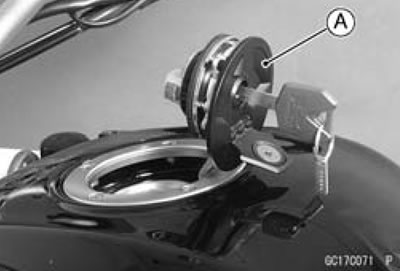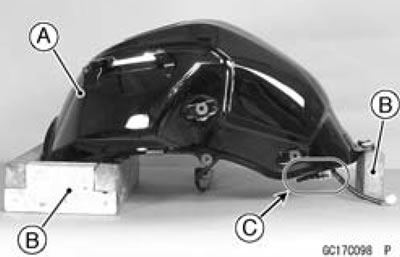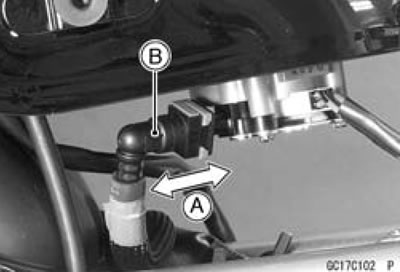Fuel Tank Removal
Warning: Gasoline is extremely flammable and can be explosive under certain conditions. Make sure the area is well-ventilated and free from any source of flame or sparks; this includes any appliance with a pilot light. Do not smoke. Turn the ignition switch OFF. Be prepared for fuel spillage; any spilled fuel must be completely wiped up immediately.
- Turn the ignition switch and engine stop switch OFF.
- Wait until the engine cools down.
- Open the fuel tank cap [A] to lower the pressure in the tank.
During tank removal, keep the tank cap open to release pressure in the tank. This makes fuel spillage less.

Remove:
- Seat (See Seat Removal in the Frame chapter)
- Side Covers (See Side Cover Removal in the Frame chapter)
- Fuel Tank Bolts [A]

- Draw the fuel out from the fuel tank with a commercially available pump [A].
- Use a soft plastic hose [B] as a pump inlet hose in order to insert the hose smoothly.
- Put the hose through the fill opening [C] into the tank and draw the fuel out.
- Front [D]
Warning: The fuel could not be removed completely from the fuel tank. Be careful for remained fuel spillage.

Disconnect:
- Fuel Pump Lead Connector [A]
- Fuel Level Sensor Lead Connector [B] Remove the fuel drain hose [C].

- Be sure to place a piece of cloth [A] around the fuel hose joint.
- Insert a minus screwdriver [B] into the slit [C] on the joint lock.

- Turn the driver [A] to disconnect the joint lock [B].
- Pull [C] the fuel hose joint out [D] of the outlet pipe.
Caution: When removing the fuel hose joint, do not apply strong force to the outlet pipe on the fuel pump. The pipe made from resin could be damaged.

Warning: Be prepared for fuel spillage; any spilled fuel must be completely wiped up immediately. When the fuel hose is disconnected, fuel spills out from the hose and the pipe because of residual pressure. Cover the hose connection with a piece of clean cloth to prevent fuel spillage.
- Close the fuel tank cap.
- Remove the fuel tank [A], and place it on a plank [B].
Do not apply the load to the fuel pump outlet portion [C] especially the outlet pipe made from resin.

Fuel Tank Installation
- Note the above WARNING (See Fuel Tank Removal).
- Route the hoses correctly (See Cable, Wire, and Hose Routing in the Appendix chapter).
- Check that the rubber dampers [A] are on the frame and the fuel tank.

- Check that the dampers [A] are in place on the fuel tank as well.
If the dampers are damaged or deteriorated, replace them.

- Be sure that the trim seal [A] is on the fuel tank.
- Reverse Side of Fuel Tank [B]
- Side Cover [C]
- Approx. 30 mm (1.2 in.) [D]
- Front [E]

- Insert [A] the fuel hose joint [B] straight onto the delivery pipe until the hose joint clicks.
Caution: When installing the fuel hose joint, do not apply strong force to the outlet pipe on the fuel pump. The pipe made from resin could be damaged.
- Push the joint lock [C] .
- Push and pull [A] the hose joint [B] back and forth more than two times and make sure it is locked and doesn't come off.

Warning: Make sure the hose joint is installed correctly on the delivery pipe by sliding the joint, or the fuel could leak.
If it comes off, reinstall the hose joint.
- Connect the fuel pump and the fuel level sensor connectors and the battery (-) cable terminal.

Fuel Tank and Cap Inspection
- Visually inspect the gasket [A] on the tank cap for any damage.
Replace the gasket if it is damaged.
- Check to see if the water drain pipe [B] and fuel breather pipe [C] in the tank is not clogged. check the tank cap breather also.
If they are clogged, remove the tank and drain it, and then blow the breather free with compressed air.
Caution: Do not apply compressed air to the air vent holes [D] in the tank cap. This could cause damage and clogging of the labyrinth in the cap.

Fuel Tank Cleaning
Warning: Clean the tank in a well-ventilated area, and take care that there are no sparks or flame anywhere near the working area. Because of the danger or highly flammable liquids, do not use gasoline or low-flash point solvents to clean the tank.
- Remove the fuel tank (See Fuel Tank Removal).
- Remove the fuel pump inlet hose and the fuel pump (See Fuel Pump Removal).
- Pour some high-flash point solvent into the fuel tank and shake the tank to remove dirt and fuel deposits.
- Draw the solvent out of the fuel tank.
- Dry the tank with compressed air.
- Install the fuel pump (See Fuel Pump Installation).
- Install the fuel tank (See Fuel Tank Installation).
